Abstract
A genetically engineered fusion protein consisting of a human/mouse chimeric anti-ganglioside GD2 antibody (ch14.18) and recombinant human interleukin 2 (rhIL-2) was tested for its ability to target rhIL-2 to tumor sites and stimulate immune effector cells sufficiently to achieve effective tumor cell lysis in vivo. The ch14.18-IL-2 fusion protein proved more effective than equivalent doses of rhIL-2 in suppressing dissemination and growth of human neuroblastoma in an experimental hepatic metastases model of scid (severe combined immunodeficiency) mice reconstituted with human lymphokine-activated killer cells. The ch14.18-IL-2 fusion protein was also more proficient than equivalent doses of rhIL-2 in prolonging the life-span of these animals. This recombinant antibody-cytokine fusion protein may prove useful for future treatment of GD2-expressing human tumors in an adjuvant setting.
Full text
PDF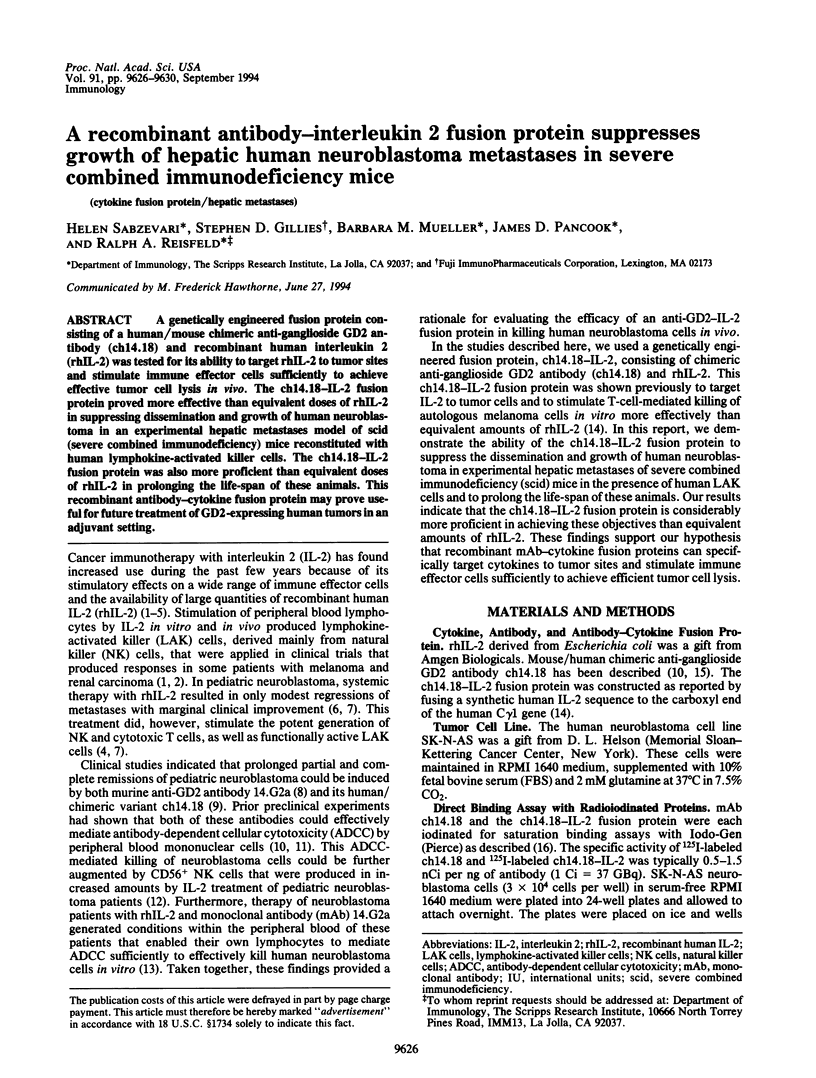
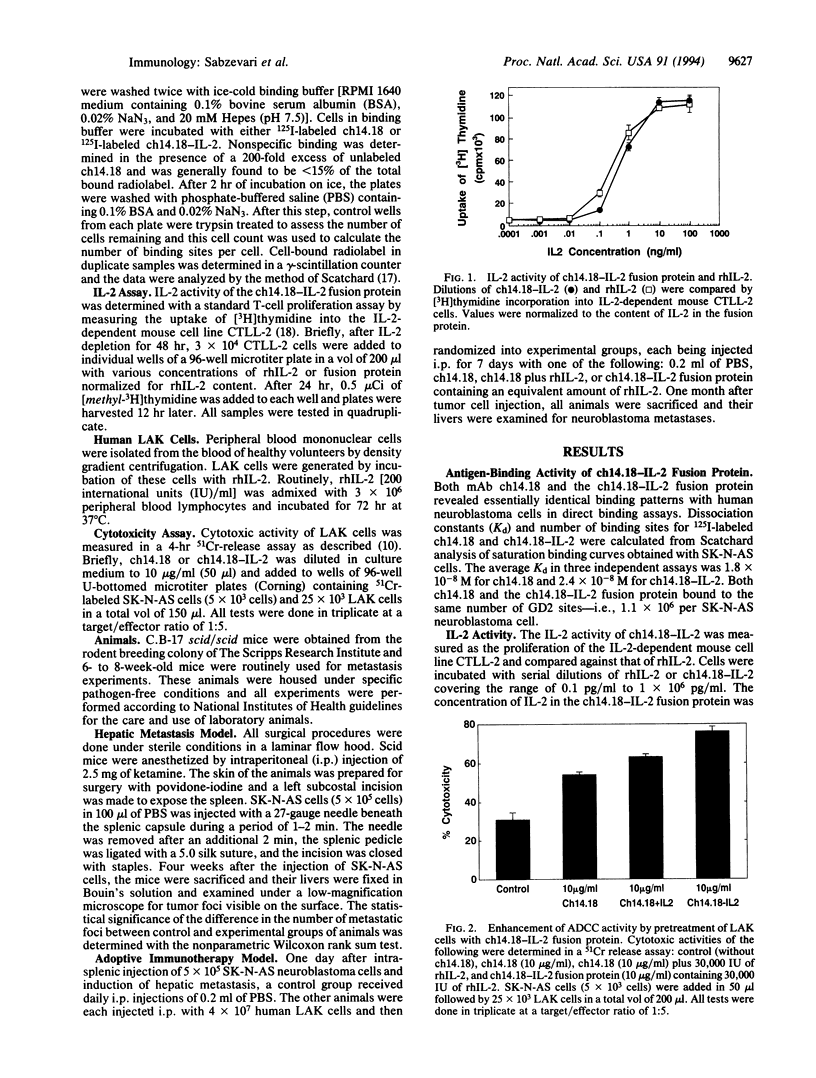
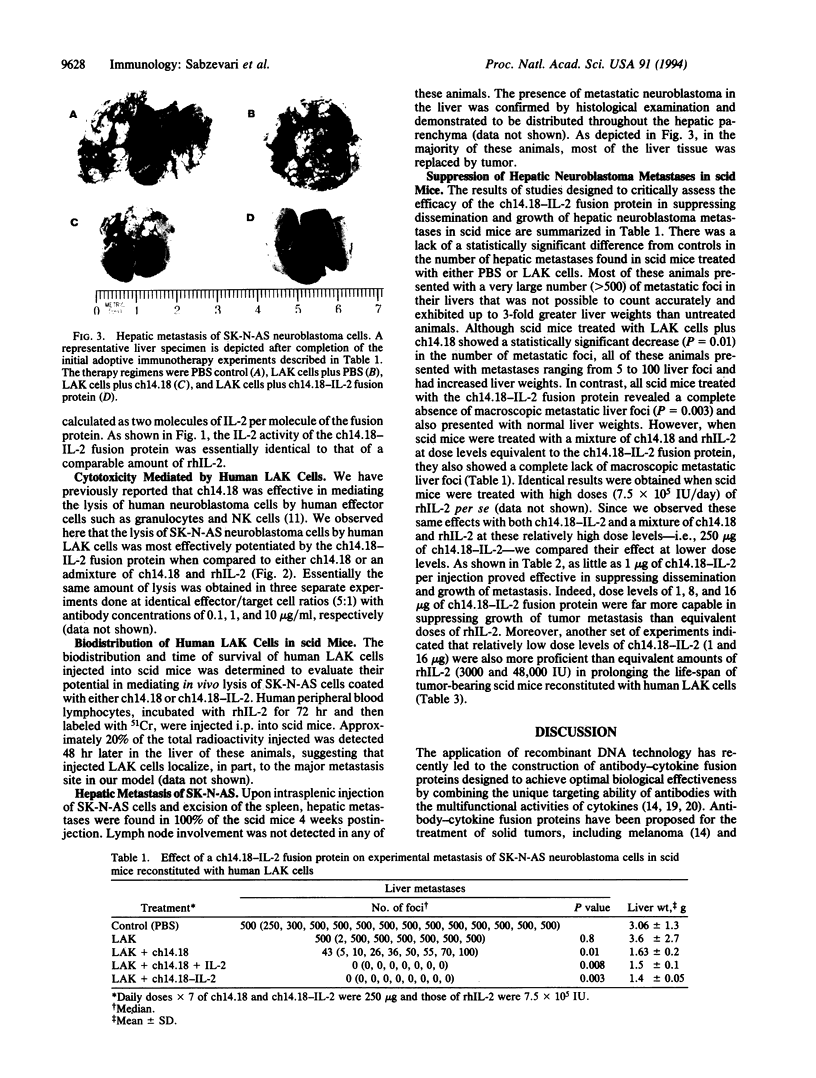
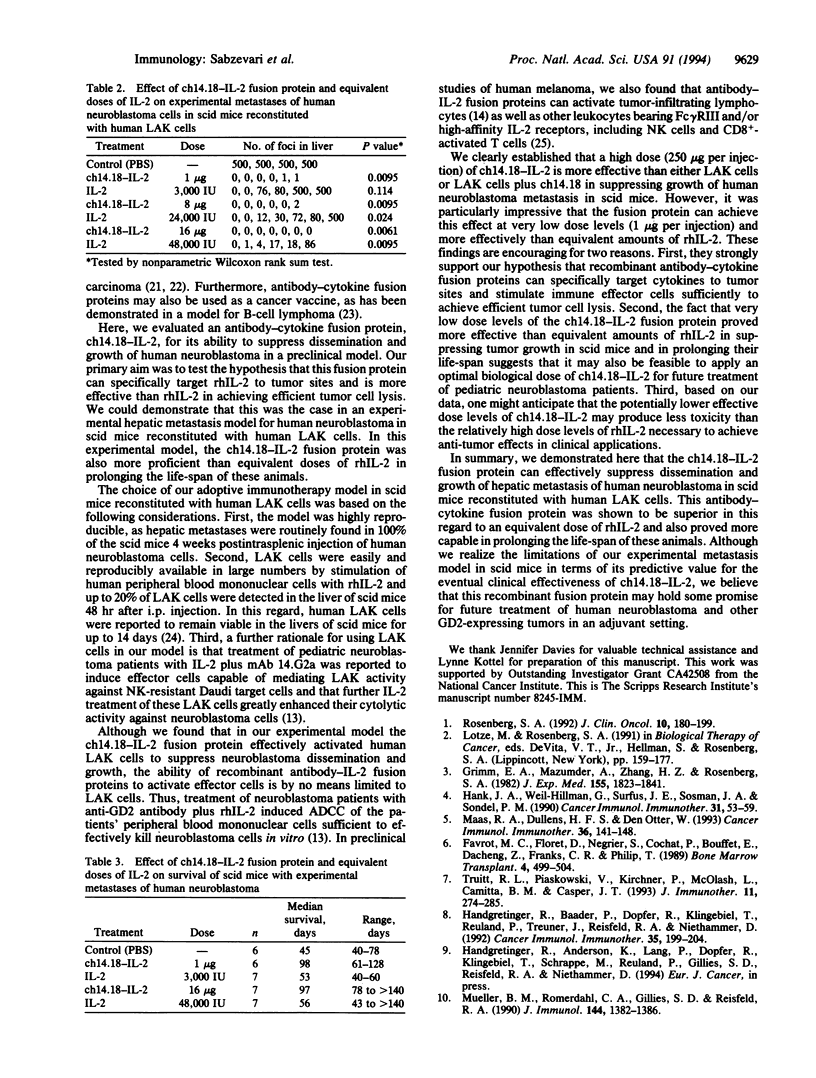
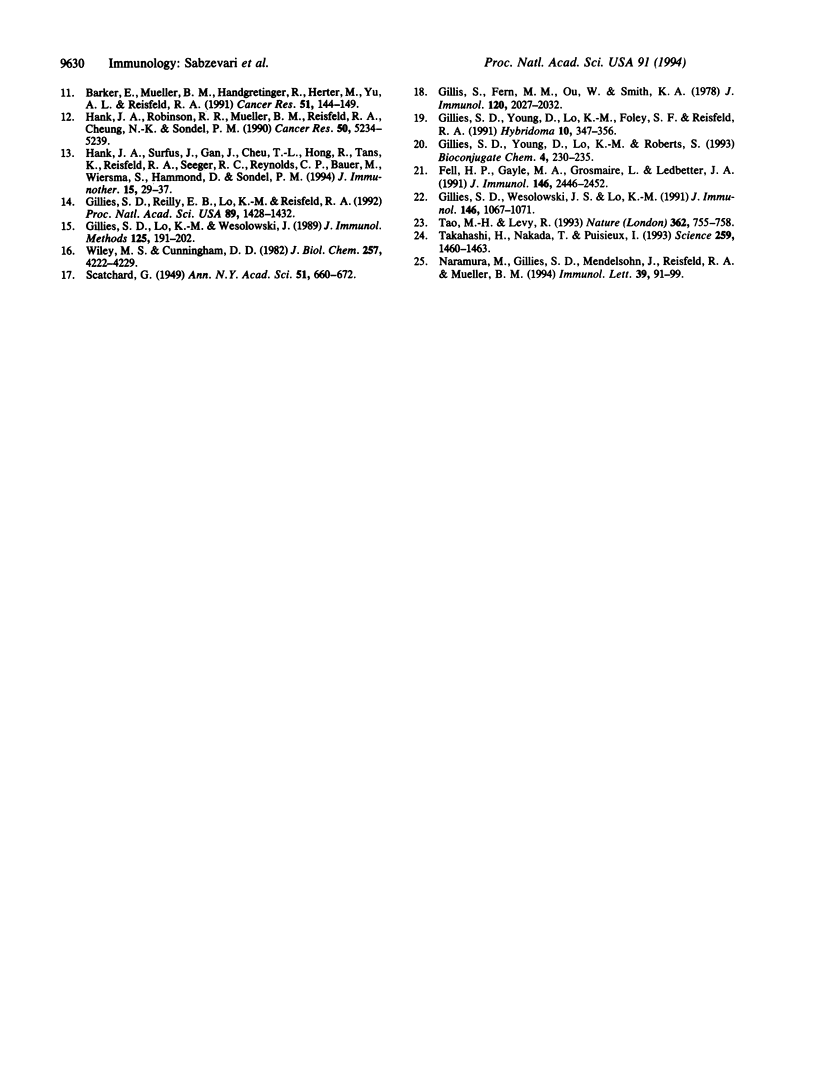
Images in this article
Selected References
These references are in PubMed. This may not be the complete list of references from this article.
- Barker E., Mueller B. M., Handgretinger R., Herter M., Yu A. L., Reisfeld R. A. Effect of a chimeric anti-ganglioside GD2 antibody on cell-mediated lysis of human neuroblastoma cells. Cancer Res. 1991 Jan 1;51(1):144–149. [PubMed] [Google Scholar]
- Favrot M. C., Floret D., Negrier S., Cochat P., Bouffet E., Zhou D. C., Franks C. R., Bijman T., Brunat-Mentigny M., Philip I. Systemic interleukin-2 therapy in children with progressive neuroblastoma after high dose chemotherapy and bone marrow transplantation. Bone Marrow Transplant. 1989 Sep;4(5):499–503. [PubMed] [Google Scholar]
- Fell H. P., Gayle M. A., Grosmaire L., Ledbetter J. A. Genetic construction and characterization of a fusion protein consisting of a chimeric F(ab') with specificity for carcinomas and human IL-2. J Immunol. 1991 Apr 1;146(7):2446–2452. [PubMed] [Google Scholar]
- Gillies S. D., Lo K. M., Wesolowski J. High-level expression of chimeric antibodies using adapted cDNA variable region cassettes. J Immunol Methods. 1989 Dec 20;125(1-2):191–202. doi: 10.1016/0022-1759(89)90093-8. [DOI] [PubMed] [Google Scholar]
- Gillies S. D., Reilly E. B., Lo K. M., Reisfeld R. A. Antibody-targeted interleukin 2 stimulates T-cell killing of autologous tumor cells. Proc Natl Acad Sci U S A. 1992 Feb 15;89(4):1428–1432. doi: 10.1073/pnas.89.4.1428. [DOI] [PMC free article] [PubMed] [Google Scholar]
- Gillies S. D., Wesolowski J. S., Lo K. M. Targeting human cytotoxic T lymphocytes to kill heterologous epidermal growth factor receptor-bearing tumor cells. Tumor-infiltrating lymphocyte/hormone receptor/recombinant antibody. J Immunol. 1991 Feb 1;146(3):1067–1071. [PubMed] [Google Scholar]
- Gillies S. D., Young D., Lo K. M., Foley S. F., Reisfeld R. A. Expression of genetically engineered immunoconjugates of lymphotoxin and a chimeric anti-ganglioside GD2 antibody. Hybridoma. 1991 Jun;10(3):347–356. doi: 10.1089/hyb.1991.10.347. [DOI] [PubMed] [Google Scholar]
- Gillies S. D., Young D., Lo K. M., Roberts S. Biological activity and in vivo clearance of antitumor antibody/cytokine fusion proteins. Bioconjug Chem. 1993 May-Jun;4(3):230–235. doi: 10.1021/bc00021a008. [DOI] [PubMed] [Google Scholar]
- Gillis S., Ferm M. M., Ou W., Smith K. A. T cell growth factor: parameters of production and a quantitative microassay for activity. J Immunol. 1978 Jun;120(6):2027–2032. [PubMed] [Google Scholar]
- Grimm E. A., Mazumder A., Zhang H. Z., Rosenberg S. A. Lymphokine-activated killer cell phenomenon. Lysis of natural killer-resistant fresh solid tumor cells by interleukin 2-activated autologous human peripheral blood lymphocytes. J Exp Med. 1982 Jun 1;155(6):1823–1841. doi: 10.1084/jem.155.6.1823. [DOI] [PMC free article] [PubMed] [Google Scholar]
- Handgretinger R., Baader P., Dopfer R., Klingebiel T., Reuland P., Treuner J., Reisfeld R. A., Niethammer D. A phase I study of neuroblastoma with the anti-ganglioside GD2 antibody 14.G2a. Cancer Immunol Immunother. 1992;35(3):199–204. doi: 10.1007/BF01756188. [DOI] [PMC free article] [PubMed] [Google Scholar]
- Hank J. A., Robinson R. R., Surfus J., Mueller B. M., Reisfeld R. A., Cheung N. K., Sondel P. M. Augmentation of antibody dependent cell mediated cytotoxicity following in vivo therapy with recombinant interleukin 2. Cancer Res. 1990 Sep 1;50(17):5234–5239. [PubMed] [Google Scholar]
- Hank J. A., Surfus J., Gan J., Chew T. L., Hong R., Tans K., Reisfeld R., Seeger R. C., Reynolds C. P., Bauer M. Treatment of neuroblastoma patients with antiganglioside GD2 antibody plus interleukin-2 induces antibody-dependent cellular cytotoxicity against neuroblastoma detected in vitro. J Immunother Emphasis Tumor Immunol. 1994 Jan;15(1):29–37. doi: 10.1097/00002371-199401000-00004. [DOI] [PubMed] [Google Scholar]
- Hank J. A., Weil-Hillman G., Surfus J. E., Sosman J. A., Sondel P. M. Addition of interleukin-2 in vitro augments detection of lymphokine-activated killer activity generated in vivo. Cancer Immunol Immunother. 1990;31(1):53–59. doi: 10.1007/BF01742496. [DOI] [PMC free article] [PubMed] [Google Scholar]
- Maas R. A., Dullens H. F., Den Otter W. Interleukin-2 in cancer treatment: disappointing or (still) promising? A review. Cancer Immunol Immunother. 1993;36(3):141–148. doi: 10.1007/BF01741084. [DOI] [PMC free article] [PubMed] [Google Scholar]
- Mueller B. M., Romerdahl C. A., Gillies S. D., Reisfeld R. A. Enhancement of antibody-dependent cytotoxicity with a chimeric anti-GD2 antibody. J Immunol. 1990 Feb 15;144(4):1382–1386. [PubMed] [Google Scholar]
- Naramura M., Gillies S. D., Mendelsohn J., Reisfeld R. A., Mueller B. M. Mechanisms of cellular cytotoxicity mediated by a recombinant antibody-IL2 fusion protein against human melanoma cells. Immunol Lett. 1993 Dec;39(1):91–99. doi: 10.1016/0165-2478(93)90169-3. [DOI] [PubMed] [Google Scholar]
- Rosenberg S. A. Karnofsky Memorial Lecture. The immunotherapy and gene therapy of cancer. J Clin Oncol. 1992 Feb;10(2):180–199. doi: 10.1200/JCO.1992.10.2.180. [DOI] [PubMed] [Google Scholar]
- Takahashi H., Nakada T., Puisieux I. Inhibition of human colon cancer growth by antibody-directed human LAK cells in SCID mice. Science. 1993 Mar 5;259(5100):1460–1463. doi: 10.1126/science.8451642. [DOI] [PubMed] [Google Scholar]
- Tao M. H., Levy R. Idiotype/granulocyte-macrophage colony-stimulating factor fusion protein as a vaccine for B-cell lymphoma. Nature. 1993 Apr 22;362(6422):755–758. doi: 10.1038/362755a0. [DOI] [PubMed] [Google Scholar]
- Truitt R. L., Piaskowski V., Kirchner P., McOlash L., Camitta B. M., Casper J. T. Immunological evaluation of pediatric cancer patients receiving recombinant interleukin-2 in a phase I trial. J Immunother (1991) 1992 May;11(4):274–285. doi: 10.1097/00002371-199205000-00006. [DOI] [PubMed] [Google Scholar]
- Wiley H. S., Cunningham D. D. The endocytotic rate constant. A cellular parameter for quantitating receptor-mediated endocytosis. J Biol Chem. 1982 Apr 25;257(8):4222–4229. [PubMed] [Google Scholar]



